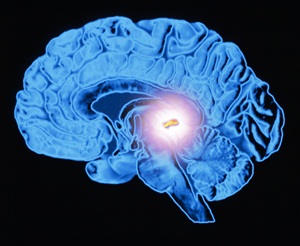Pineal gland
The pineal gland is situated in the middle of the human brain and is the major site of the body’s melatonin production.
Alternative names for the pineal gland
Pineal body; epiphysis cerebri; epiphysis

Computer artwork of a sectioned human brain in side view, showing the pineal gland (highlighted). Front of the brain is at left. The pineal gland is situated deep within the brain, just below the back of the corpus callosum.
Where is the pineal gland?
The pineal gland is located deep in the brain in an area called the epithalamus, where the two halves of the brain join. In humans, this is situated in the middle of the brain; it sits in a groove just above the thalamus, which is an area that co-ordinates a variety of functions related to our senses. The pineal gland contains high levels of calcium and can be used by radiographers to mark the middle of the brain in X-ray images.
What does the pineal gland do?
The pineal gland is best known for the secretion of the hormone melatonin, which is released into the blood and possibly also into the brain fluid, known as cerebrospinal fluid. Pineal melatonin is a hormone that regulates the body’s daily (circadian) clock and so melatonin is commonly used in human research to understand the body’s biological time. There is a rhythm to the biology of the pineal gland and melatonin is secreted according to the amount of day light a person is exposed to. It varies with changes in day length and this is why the pineal gland is sometimes referred to as both an endocrine clock and an endocrine calendar.
Melatonin secreted by the pineal gland is an important part of the body’s circadian timing system and can synchronise daily rhythms (see the articles on jet lag and circadian rhythm sleep disorders). Melatonin is secreted more when it is dark which explains melatonin’s role in sleep. There is considerable research that shows that without the pineal gland and its secretion of melatonin, animals are unable to adapt physiologically to seasonal changes.
What hormones does the pineal gland produce?
The major hormone produced by the pineal gland is melatonin.
What could go wrong with the pineal gland?
It is not unusual to see pineal cysts on magnetic resonance imaging (MRI) scans. These are benign and not harmful. However, on rare occasions, tumours of the pineal gland are found. There are some extremely rare reports of precocious puberty (early puberty) in individuals with pineal gland cysts or tumours. It is not clear whether these changes in puberty are caused by melatonin or some other hormone, such as human chorionic gonadotrophin , which is reported to be released by some pineal tumours. Otherwise, there are no known diseases associated with over or underactivity of the pineal gland.